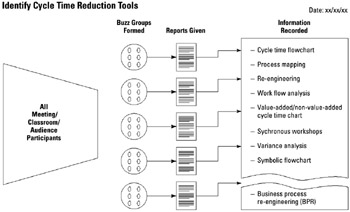Tool 23: Buzz Group
| AKA | Buzzing |
| Classification | Team Building (TB) |
Tool description
The buzz group technique is of great assistance to team facilitators or presenters when there is a lack of participation or intra-group communication and more involvement is desired. It can be used to initiate discussion on perceived problems, to share experiences and lessons learned, or to achieve team consensus.
Typical application
-
To explore in detail, and with full participation, process improvement opportunities or ideas for problem resolution.
-
To receive each participant's feedback on some issue or experience.
-
To involve all persons in the learning process.
Problem-solving phase
| → | Select and define problem or opportunity |
| → | Identify and analyze causes or potential change |
| → | Develop and plan possible solutions or change |
| Implement and evaluate solution or change | |
| Measure and report solution or change results | |
| → | Recognize and reward team efforts |
Typically used by
| Research/statistics | |
| 1 | Creativity/innovation |
| Engineering | |
| 3 | Project management |
| Manufacturing | |
| Marketing/sales | |
| Administration/documentation | |
| Servicing/support | |
| Customer/quality metrics | |
| 2 | Change management |
before
-
Circle response
-
Circles of Knowledge
-
Round Robin Brainstorming
-
Interview technique
-
Surveying
after
-
Consensus decision
-
Phillips 66
-
Critical Dialogue
-
Wildest Idea Technique
-
Presentation
Notes and key points
-
Buzz group size: 4–6 participants.
-
Position chairs in a circle so that participants face each other.
Step-by-step procedure
-
STEP 1 The team facilitator, instructor, or presenter states the purpose for buzzing, asks participants to face one another, and informs all buzz groups that they have approximately eight minutes to "buzz" their topic. Each buzz group selects a spokesperson.
-
STEP 2 A problem, issue, or idea is displayed to all buzz groups. Groups begin to sort, discuss, or summarize information. See example Identify Cycle Time Reduction Tools.
-
STEP 3 After the allowed time limit, buzz groups are asked to report their findings or ideas.
-
STEP 4 The facilitator, instructor, or presenter records findings or ideas on flip charts for everyone to see.
-
STEP 5 Information generated is dated and used on the spot or saved for later reference.
Example of tool application

EAN: 2147483647
Pages: 326